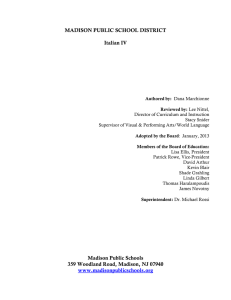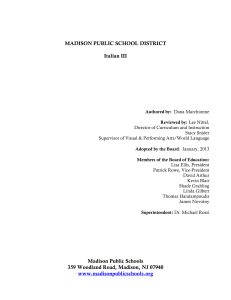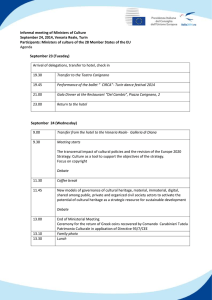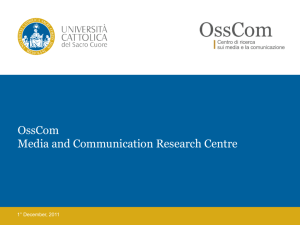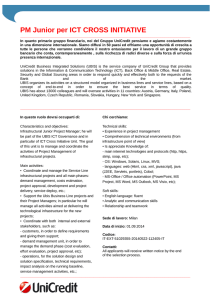MADISON PUBLIC SCHOOL DISTRICT Italian I MHS
advertisement
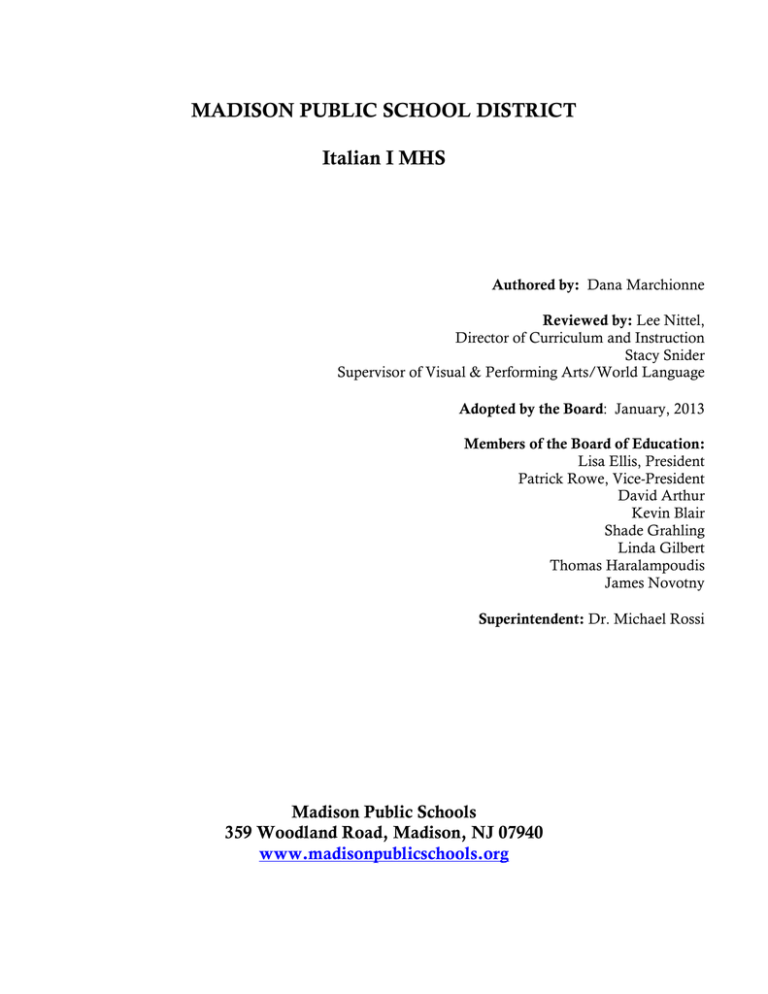
MADISON PUBLIC SCHOOL DISTRICT Italian I MHS Authored by: Dana Marchionne Reviewed by: Lee Nittel, Director of Curriculum and Instruction Stacy Snider Supervisor of Visual & Performing Arts/World Language Adopted by the Board: January, 2013 Members of the Board of Education: Lisa Ellis, President Patrick Rowe, Vice-President David Arthur Kevin Blair Shade Grahling Linda Gilbert Thomas Haralampoudis James Novotny Superintendent: Dr. Michael Rossi Madison Public Schools 359 Woodland Road, Madison, NJ 07940 www.madisonpublicschools.org I. OVERVIEW Italian I begins the Italian language sequence at Madison High School. This full year course provides an introduction to the four basic communication skills of language learning: listening, speaking, reading and writing with an emphasis on the oral/aural skills. All objectives are practiced with the goal of communicative and cultural awareness. Students will communicate with spoken and written forms using interpretive, interpersonal, and presentational modes. Students will demonstrate understanding of a culture via these same three modes. II. RATIONALE New Jersey citizens are part of a dynamic, interconnected, and technologically driven global society centered on the creation and communication of knowledge and ideas across geographical, cultural, and linguistic borders. Individuals who effectively communicate in more than one language, with an appropriate understanding of cultural contexts, are globally literate. The study of another language and culture enables individuals to communicate with people from diverse cultures. The study of another language fosters attitudes, values, and skills that indicate a positive disposition and understanding of cultural differences and that enhance cross-cultural communication. III. GOALS (Linked to NJ Core Content Standards) 7.1 World Languages: All students will be able to use a world language in addition to English to engage in meaningful conversation, to understand and interpret spoken and written language, and to present information, concepts, and ideas, while also gaining an understanding of the perspectives of other cultures. Through language study, they will make connections with other content areas, compare the language and culture studied with their own, and participate in home and global communities. Language learners can be expected to move through levels of proficiency at different rates. In addition, language learners may demonstrate differing proficiencies depending upon the communicative mode in which they are functioning (interpersonal, interpretive, or presentational). In Madison High School, students who are taking Italian I should meet the cumulative progress indicators for the Intermediate-Mid Level of proficiency. Intermediate-Mid Level students communicate using strings of sentences to ask and answer questions, to handle simple transactions related to everyday life, and to talk about subject matter studied in other classes. By the end of Italian I, students taking a continuing sequence of language from middle school will: A. Interpretive Mode: 1. Compare and contrast information contained in culturally authentic material using electronic information sources related to targeted themes. 2. Demonstrate comprehension of oral and written instructions connected to daily activities and to some unfamiliar situations through appropriate responses. 3. Analyze the use of verbal and non-verbal etiquette (i.e., gestures, intonation, and cultural practices) in the target culture(s) to determine the meaning of a message. 4. Use target language to paraphrase what is heard or read in oral or written descriptions of people, places, objects, and daily activities. 5. Comprehend conversations and written information on a variety of familiar and some unfamiliar topics. 6. Compare and contrast the main idea, theme, main characters, and setting in readings from age-and levelappropriate, culturally authentic. 7. Infer the meaning of some unfamiliar words in some new contexts. 8. Use knowledge of structures of the target language to deduce meaning of new and unfamiliar structures. B. Interpersonal Mode: 1. Use digital tools to participate in short conversations and to exchange information related to a variety of familiar topics and some unfamiliar topics. 2. Give and follow a series of oral and written directions, commands, and requests for participating in ageand level- appropriate classroom and cultural activities in familiar and unfamiliar situations. 3. Use appropriate gestures, intonation, and common idiomatic expressions of the target culture(s)/language in familiar and some unfamiliar situations. 4. Ask and respond to factual and interpretive questions of a personal nature, on school related topics, and on some unfamiliar topics and situations. 5. Engage in short conversations about personal experiences or events, topics studied in other content areas, and some unfamiliar topics and situations. C. Presentational Mode 1. Synthesize information related to the cultural products, cultural practices, and cultural perspectives associated with targeted culture(s) to create a multimedia-rich presentation on targeted themes to be shared virtually with a target language audience. 2. Dramatize student-created and/or authentic short plays, skits, poems, songs, stories, or reports. 3. Use language creatively to respond in writing to a variety of oral or visual prompts about familiar and some unfamiliar situations. 4. Synthesize information found in age- and level-appropriate culturally authentic materials. 5. Compare the cultural perspectives of the target culture(s) with those of one’s own culture, as evidenced through the cultural products and cultural practices associated with each. IV. ESSENTIAL CONTENT AND ACTIVITES See attached., “Scope & Sequence”. V. EVALUATION Listening, speaking, reading and writing in a variety of modes will be considered to determine the final grade. Assessments will include: ▪ Tests and quizzes that accompany the text ▪ Teacher-made achievement tests and quizzes ▪ Aural testing ▪ Oral testing in interpersonal and presentational modes ▪ Written evaluations in interpersonal and presentational modes ▪ Student projects and presentations ▪ Homework VI. RESOURCES CIAO!, Sixth Edition: Carla Larese Riga Madison School District Italian I - Scope and Sequence Unit of Study Preliminary Unit Key Vocabulary/ Language in Key Use Vocabulary/ Language in Use • Pronunciation • Syllables • Intonation • Introductions • Salutations and expressions of courtesy • Classroom expression • Numbers • The Calendar • Culture – Italian Language & its Dialects Activities/Assessment/Project Activities/Assessment/Project • • • • • • • • • • • • • Pronunciation Cards Mamma Mia Matematica con I Numeri Scavenger Hunts Relay Races Slap it Smart Board Activities Listening Activities Card Games Songs Posters Bulletin Boards Picture/ Visual cues Cultural Connections Cultural Connections • • • • • • • • La Lingua Italiana I Dialetti TV & Film Sports I Giornali Le Reviste Le Persone Famose Musica Italiana Related Literature, Video, and Related Songs Literature, Video, and Songs • Italian National Anthem • Italian Vs. European stereotypes • La Lettura – I Dialetti • Il Video – “ Come Stai?” • Sito WEB Unit of Study Capitolo 1 – La Città Key Vocabulary/ Language in Use • In Centro • La Città • Ufficio Turistico • Essere -c’è, ci sono, ecco • Il nome • Gli articoli • Espressioni interrogative • Cosa c’è in una città? • Parliamo & Scriviamo insieme • Cultura - Milano / La Lombardia Activities/Assessment/Project • • • • • • • • • • • • • • • • • • • • Quaderni di esercizi Una Mappa della città Ascolti Charts Conversazione Adjective card game Magazine cut-outs Smart Board Famous People Pictionary Relay Races “Slap It” Una Gara Horoscope Listening Activities Group Dialog & Presentations Internet games / activities Quia Compiti / Compitini Cultural Connections • • • • • • La Carta Geografica In Tabaccheria Azienda di Promozione Turistica del Milanese Il Teatro I Negozi Il Duomo Related Literature, Video, and Songs • • • • Sito WEB Video – In Centro La Lombardia – Il video ed La Lettura La Lombardia – I Scrittori Famosi Unit of Study Key Vocabulary/ Language in Use • Capitolo 2 – Persone e personalità • • • • • • • Com’è il tuo compagno di stanza? La Descrizione La sera della festa L’aggettivo Buono/Bello Avere Frasi ideomatiche con AVERE Cultura – Il turismo nelle regioni d’italia & informazioni geografiche Activities/Assessment/Project • • • • • • • • • • • • • • Adjective card game Magazine cut-outs Smart Board Famous People Pictionary Relay Races “Slap It” Una Gara Horoscope Listening Activities Group Dialog & Presentations Internet games / activities Quia Compiti / Compitini Cultural Connections • • • • • • • La Bandiera Italiana Musica TV I Giornali I Telegiornali Il Calcio Complimenti & Abitudini Related Literature, Video, and Songs • • • • • Musica - Nicola Arigliano, “Carina” Università Stranieri di Siena Sito WEB Attori Famosi La lettura delle informazioni geografiche Unit of Study Capitolo 3 – All’univers ità Key Vocabulary/ Language in Use • • • • • • • • Gli esami Il sistema Italiano degli studi In Classe Verbi Regolari al Presente (-ARE) Le Preposizioni Le Preposizioni Avverbiali Quale? E Che? Cultura – Una Sceda Personale & Informazioni Scolastiche Activities/Assessment/Project • • • • • • • • • • • • • • • • • • • • Quaderni di esercizi La Pagella Italiana (Report Card) Ascolti Charts Conversazione Card game Magazine cut-outs Smart Board People Pictionary Relay Races “Slap It” Una Gara Listening Activities Group Dialog & Presentations Internet games / activities Quia Compiti / Compitini Scriviamo La Scheda Personale Cultural Connections • L’universita di Firenze • Gli Esami • La Scuola Italiana • Il Sistema -Similarities -Differences • Musica • TV • I Giornali • I Telegiornali • Le Città ed Gli Università • Facoltà e Diplomi di Laurea • Un/Una Studente/Studentessa universitario/a • Studiare all’estero Related Literature, Video, and Songs • • • • • • • • Cantanti Famosi Scrittori Famosi Chi Va a L’università? Corsi Di Laurea Sito WEB Ascolto – Liceo Le Pubblicità – Gli Annunci - Cerco una Stanza. Unit of Study Capitolo 4 – A Tavola Key Vocabulary/ Language in Use Al Ristorante Pasti e piatti Colazione Verbi Regolari al Presente (-ERE) & (-IRE) (*isc) • Il Partitivo -alcuni -qualche -un po di -di + articoli • Quanto • I Numeri Cardinali • Molto, Tanto, Troppo, Poco, Tutto, Ogni • Cultura – Dove andiamo a mangiare? & I pasti degli Italiani • • • • Activities/Assessment/Project • • • • • • • • • • • • • • • • • • Dialoghi Ascolti Charts Conversazione Card game Magazine cut-outs Smart Board People Pictionary Relay Races “Slap It” Una Gara Listening Activities Group Dialog & Presentations Internet games / activities Quia Compiti / Compitini Scriviamo Cultural Connections • • Il Cibo Italiano Il menù tipico • • • • • • I Ristoranti In Trattoria In Pizzeria Al Tavola Calda In Paninoteca Al Bar • • Ordinare (Non) Mi Piace/Piacciono La Lista Della Spesa (Shopping List) Il Compleanno Celebriamo Facciamo un Brindisi La Dieta Personale Un Picnic – Facciamo una Scampagnata • • • • • • Related Literature, Video, and Songs Il Video “Al Ristorante” Sito WEB Intermezzo Musicale – Giorgio Conte “Cannelloni” • Lo Scontrino (Pane, Coperto, e Servizio) • • •
